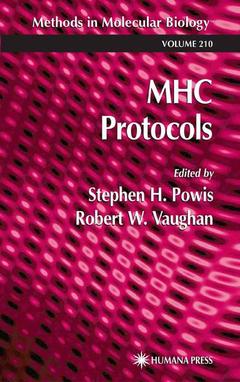Description
MHC Protocols, Softcover reprint of the original 1st ed. 2003
Methods in Molecular Biology Series, Vol. 210
Coordinators: Powis Stephen H., Vaughan Robert W.
Language: English
Subject for MHC Protocols:
MHC Protocols
Publication date: 08-2013
340 p. · 15.2x22.9 cm · Paperback
Publication date: 08-2013
340 p. · 15.2x22.9 cm · Paperback
MHC Protocols (Methods in molecular biology, vol. 210)
340 p. · 15.5x23.5 cm · Hardback
340 p. · 15.5x23.5 cm · Hardback
Description
/li>Contents
/li>Comment
/li>
The aim of MHC Protocols is to document protocols that can be used for the analysis of genetic variation within the human major histocompatibility complex (MHC; HLA region). The human MHC encompasses approximately 4 million base pairs on the short arm of chromosome 6 at cytogenetic location 6p21. 3. The region is divided into three subregions. The telomeric class I region contains the genes that encode the HLA class I molecules HLA-A, -B, and -C. The centromeric class II region contains the genes encoding the HLA class II molecules HLA-DR, -DQ, and -DP. In between is the class III region, originally identified because it contains genes encoding components of the complement pathway. The entire human MHC has recently been sequenced (1) and each subregion is now known to contain many other genes, a number of which have immunological functions. The study of polymorphism within the MHC is well established, because the region contains the highly polymorphic HLA genes. HLA polymorphism has been used extensively in solid organ and bone marrow transplantation to match donors and recipients. As a result, large numbers of HLA alleles have been identified, a process that has been further driven by recent interest in HLA gene diversity in ethnic populations. The extreme genetic variation in HLA genes is believed to have been driven by the evolutionary response to infectious agents, but relatively few studies have analyzed associations between HLA genetic variation and infectious disease, which has been difficult to demonstrate.
Databases.- HLA Informatics.- Accessing HLA Sequencing Data Through the 6ace Database.- Polymorphism in Classical and Nonclassical Hla Genes.- HLA Typing by Restriction Fragment Length Polymorphism Analysis.- PCR-Restriction Fragment Length Polymorphism Typing of Class I and II Alleles.- PCR-Sequence-Specific Oligonucleotide Probe Typing for HLA-A, -B, and -DR.- HLA-DPA1 and -DPB1 Typing Using the PCR and Nonradioactive Sequence-Specific Oligonucleotide Probes.- PCR-Sequence-Specific Primer Typing of HLA Class I and Class II Alleles.- HLA Typing With Reference Strand-Mediated Conformation Analysis.- Sequencing Protocols for Detection of HLA Class I Polymorphism.- HLA-E and HLA-G Typing.- Typing Alleles of HLA-DM.- Polymorphism in Non-Hla Mhc Genes.- Typing Alleles of TAP1 and TAP2.- Determining Alleles of the C2 Gene by Southern Blotting.- Complement C4 Protein and DNA Typing Methods.- Typing of Tumor Necrosis Factor Alleles.- Molecular Typing of the MHC Class I Chain-Related Gene Locus.- Microsatellites.- HLA Microsatellite Analysis.
Includes supplementary material: sn.pub/extras
© 2024 LAVOISIER S.A.S.




